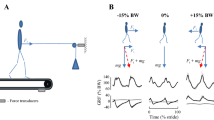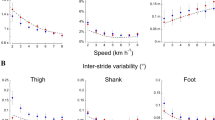Abstract
The movement strategies and the underlying organization of the muscular responses for recovery from a tripping perturbation applied in early and late swing during walking were studied in humans. The latencies of the reflex response (60–140 ms) suggested that polysynaptic pathways are involved. The most common movement outcome was an elevating strategy of the swing limb in response to the early swing perturbation and a lowering strategy in response to the late swing perturbation. The elevating strategy comprised a flexor component of the swing limb and an extensor component of the stance limb. There was a temporal sequencing of the swing limb biceps femoris prior to the swing limb rectus femoris response to remove the limb from the obstacle prior to accelerating the limb over the obstacle. The extensor response of the stance limb generated an early heel-off to increase the height of the body. Thus, the lower limb joints collaborated to increase the height of the centre of mass and provide extra time to extend the swing limb in preparation for the landing. Flexion of the swing limb would be dangerous in response to the late swing perturbation as the swing limb is approaching the ground and the body mass has passed forward of the stance foot. Instead, a lowering strategy was accomplished by inhibitory responses of the swing limb vastus lateralis and/or excitatory responses of the swing limb biceps femoris. Both these responses resulted in a rapid lowering of the limb to the ground with a flat foot or forefoot landing and a shortening of the step length. Thus, in response to the late swing perturbation, the same recovery strategy was achieved by different patterns of muscle activation. These results demonstrate that the recovery strategies provided a functionally appropriate response for overcoming the obstacle and maintaining the ongoing locomotion.
Similar content being viewed by others
References
Akazawa K, Aldridge JW, Steeves JD, Stein RB (1982) Modulation of stretch reflexes during locomotion in the mesencephalic cat. J Physiol (Lond) 329:553–567
Belanger M, Patla AE (1984) Corrective responses to perturbations applied during walking in humans. Neurosci Lett 49:291–295
Belanger M, Patla AE (1987) Phase-dependent compensatory responses to perturbation applied during walking in humans. J Mot Behav 19:434–453
Berger W, Dietz B, Quintern J (1984) Corrective reactions to stumbling in man: neuronal co-ordination of bilateral leg muscle activity in gait. J Physiol (Lond) 357:109–125
Berger W, Horstmann G, Dietz V (1988) Spastic paresis: impaired spinal reflexes and intact motor programs. J Neurol Neurosurg Psychiatry 51:568–571
Berger W, Quintern J, Dietz V (1987) Afferent and efferent control of stance and gait: developmental aspects of compensatory mechanisms. Electroencephalogr Clin Neurophysiol 61:244–252
Capaday C, Stein RB (1987) Difference in the amplitude of the human soleus H reflex during walking and running. J Physiol (Lond) 392:513–522
Crenna P, Frigo C (1984) Evidence of phase-dependent nociceptive reflexes during locomotion in man. Exp Neurol 85:336–344
Dietz V, Quintern J, Berger W (1986) Obstruction of the swing phase during gait: phase-dependent bilateral leg muscle coordination. Brain Res 384:166–169
Drew T, Rossignol S (1987) A kinematic and electromyographic study of cutaneous reflexes evoked from the forelimb of unrestrained walking cats. J Neurophysiol 57:1160–1184
Duysens J, Loeb GE (1980) Modulation of ipsi and contralateral reflex responses in unrestrained walking cats. J Neurophysiol 44:1024–1037
Duysens J, Trippel M, Horstmann GA, Dietz V (1990) Gating and reversal of reflexes in ankle muscles during human walking. Exp Brain Res 82:351–358
Forssberg H (1979) Stumbling corrective reaction: a phase-dependent compensatory reaction during locomotion. J Neurophysiol 42:936–953
Forssberg H, Grillner S, Rossignol S (1977) Phasic gain control of reflexes from the dorsum of the paw during spinal locomotion. Brain Res 132:121–139
Garret M, Luckwill RG (1983) Role of reflex responses of knee musculature during the swing phase of walking in man. Eur J Appl Physiol 52:36–41
Gauthier L, Rossignol S (1981) Contralateral hindlimb responses to cutaneous stimulation during locomotion in high decerebrate cats. Brain Res 207:303–320
Hirschfeld H, Forssberg H (1991) Phase-dependent modulations of anticipatory postural activity during human locomotion. J Neurophysiol 66:12–19
Lundberg A (1979) Multisensory control of spinal reflex pathways. Prog Brain Res 50:11–28
Lundberg A, Malmgren K, Schomburg ED (1987) Reflex pathways from group II muscle afferents. 3. Secondary spindle afferents and the FRA: a new hypothesis. Exp Brain Res 65:294–306
Macpherson JM (1988) Strategies that simplify the control of quadrupedal stance. I. Forces at the ground. J Neurophysiol 60:204–217
McFadyen BJ, Winter DA (1991) Anticipatory locomotor adjustments during obstructed human walking. Neurosci Res Commun 9:37–44
Nashner LM, McCollum G (1985) The organization of human postural movements: a formal basis and experimental synthesis. Behav Brain Sci 8:135–172
Overstall PW, Exton-Smith AN, Imms FL, Johnson AL (1977) Falls in the elderly related to postural imbalance. BMJ 1:261–264
Patla AE, Prentice SD, Robinson C, Neufeld J (1991) Visual control of locomotion: strategies for changing direction and for going over obstacles. J Exp Psychol Hum Percept Perform 17:603–634
Patla AE, Martin C, Rietdyk S (1992) The effect of visually inferred property of an obstacle on obstacle avoidance response during locomotion in humans. In: Woolacott M, Horak F (eds) Posture and gait: control mechanisms. University of Oregon Books, Eugene, pp 222–225
Smith JLS, Zernicke RF (1987) Predictions for neural control based on limb dynamics. Trends Neurosci 10:123–128
Winter DA (1990) Biomechanics and motor control of human movement, 2nd edn. Wiley, New York
Winter DA (1991) Biomechanics and motor control of human gait: normal, elderly and pathological. University of Waterloo Press, Waterloo
Winter DA, Robertson DGE (1978) Joint torque and energy patterns in normal gait. Biol Cybern 29:137–142
Yang JF, Stein RB (1990) Phase-dependent reflex reversal in human leg muscles during walking. J Neurophysiol 63:1109–1117
Author information
Authors and Affiliations
Rights and permissions
About this article
Cite this article
Eng, J.J., Winter, D.A. & Patla, A.E. Strategies for recovery from a trip in early and late swing during human walking. Exp Brain Res 102, 339–349 (1994). https://doi.org/10.1007/BF00227520
Received:
Accepted:
Issue Date:
DOI: https://doi.org/10.1007/BF00227520




